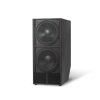OK, but as compared with what?
A comparable sealed sub? No, this is where you go wrong. If the above was true, there would be no reason for ported subs to exist at all--sealed subs would basically do everything better, all the time. Clearly that's not true.
Even "generally speaking," in general the opposite of that statement is true. Given a half-way decent design, when port compression becomes an issue it is generally at a higher output level than a similar/equivalent sealed sub is capable of producing in the first place. For an example, let's continue the one you started--the Rythmic FV18 and compare it to it's price/quality/driver size equivalent--the F18. Same brand, same price class, same sized driver, tested by the same guy (Josh Ricci) with the same methodology. Let's look at the output of the FV18:
View attachment 206915
Given that and the chart you posted above, especially knowing this sub comes with a more aggressive HPF setting to limit output below 18 Hz if desired, I think we can call the 110 dB sweep the limit of this sub's clean, worry free output. At that level, it outputs a solid 110 dB from 20 Hz on up.
Now let's compare that with it's sealed equivalent--the F18. Same sized driver, price range, brand, etc:
View attachment 206916
Here you can see significant compression up to nearly 30 Hz on the 110 dB sweep, so call the 105 dB sweep the max clean, safe output level. As you can see, at 20 Hz this sub is done at 101 dB, a solid 9 dB below the ported version's capability at that frequency. 9 dB at 20 Hz is a HUGE difference in capability--and it maintains an advantage to over 40 Hz. Anybody concerned about port compression limiting output is obviously looking for as much output as he can get down at those frequencies--and for
that person, the ported sub is the clear winner. Other people may choose the sealed for other reasons, but lack of output of the ported version close to the tuning frequency compared with a similar sealed sub is not one of them.
To take the comparison further, how does distortion compare? To keep things simple, a quick look at THD:
Ported (you're looking for the green line for the above determined output levels):
View attachment 206937
It stays below 9% to well below 20 Hz.
Sealed (you're looking for the black line):
View attachment 206938
It goes up to about 18% at 20 Hz, so certainly no advantage there.
Group delay?
View attachment 206939
View attachment 206940
It's really only different enough to make any difference (if such a thing exists

) below 30 Hz, so lack of group delay isn't going to make one better than the other for music that has no content that low anyway.
Now obviously that's just one comparison, but when comparing apples to apples subs (similar cost/quality/driver size) that's pretty much how most turn out (of somewhat decent subs, I haven't paid attention to really cheap/crappy subs where their crappiness likely precludes any generalizations from holding true) or ported subs wouldn't exist--why would anybody choose a bigger, more expensive sub if there was no advantage at all? When writing that up James Larson's recent review of the Arendal Sound 1961 1S and 1V Subwoofers came to mind as it is about as apples to apples as it gets, and the results are very much the same.
https://www.audioholics.com/subwoofer-reviews/arendal-1961-1s-1v

